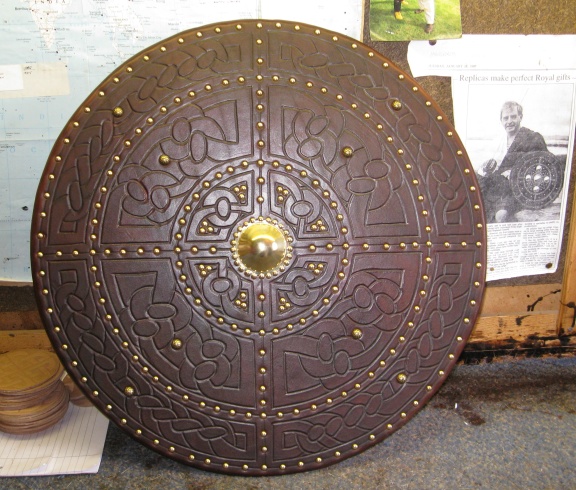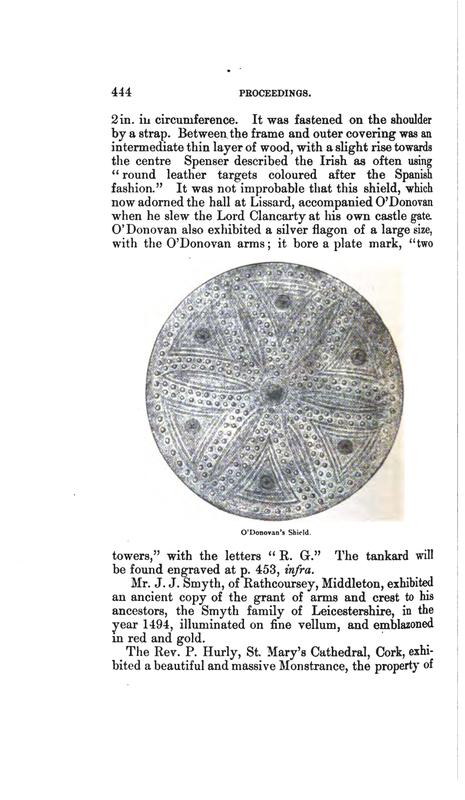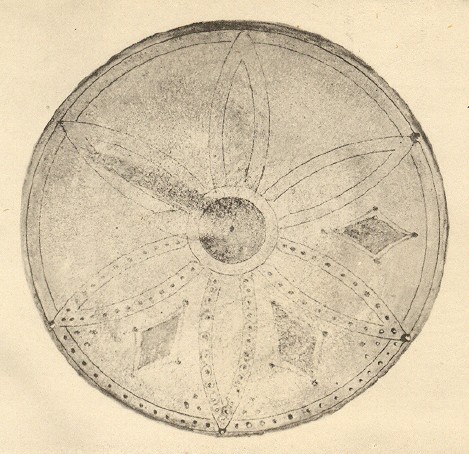Hi everyone, I have a few questions that I would be very greatfull if you guys could help me with.
1. I have heard somewhere that Irish kerns (light infantry) sometimes used wicker targes instead
of wood. Has anyone any literary or pictural evidence for this?
2. If these were used, was it because they were cheaper to make or was it because they were lighter
and therefore better for the fast moving, javelin throwing style of warfare employed be these kerns?
3. These wicker targes were probably faced with leather, but does anyone think that they also had the
charicteristic brass studs and bosses that decorate the wooden types?
Any help with these quetions would be much appreciated as I intend to make an attempt at putting one
these together.
Good day Stephen,
Very interesting question and topic. This is the first I've heard of these Irish wicker targes. It has given me something new to investigate - thanks. But, so far I haven't found a whole lot of info. I did find an article by George Bush here at myArmoury that has some info, and a possible drawing of one these targes. Also, apparently skiagh is another name for these targes. I'm sure someone else here will soon chime-in with much more information.
http://www.myArmoury.com/feature_armies_irish.html
Jim
Very interesting question and topic. This is the first I've heard of these Irish wicker targes. It has given me something new to investigate - thanks. But, so far I haven't found a whole lot of info. I did find an article by George Bush here at myArmoury that has some info, and a possible drawing of one these targes. Also, apparently skiagh is another name for these targes. I'm sure someone else here will soon chime-in with much more information.
http://www.myArmoury.com/feature_armies_irish.html
Jim
Thanks Jim for the reply. I have read the article here on myArmoury and found it very helpfull. The only other site I have found to be any help in this matter is http://www.geocities.com/na_degadmedieval_ireland/ on this site the other word used for targe is scath. Anyway neither site has any literary or pictural evidence nor do they answer question 2. or 3. above.
OK, if nobody has any info on the wicker targes questions ill move on. How about 15th and 16th century targes, does anyone know what they looked like? Were they much different from later ones? Thanks in advance Stephen.
| Stephen Curtin wrote: |
| OK, if nobody has any info on the wicker targes questions ill move on. How about 15th and 16th century targes, does anyone know what they looked like? Were they much different from later ones? Thanks in advance Stephen. |
Here are some examples of 16th century Irish targes, the first is the picture of the original, the second is a replica of it I had made by Joe Lindsey the Targemaker(he's the one in the picture next to it). It now proudly sits on my mantle on display in my living room. The last is another example from the 16th century. The first picture is in the Osprey book The Irish Wars. The O'Donovan one is also depicted in that book as drawn by McBride on the Irish Cavalryman,1578.



Here is a description of the ODonovan shield depicted in the last post it is from the page before it. These 2 pages are both courtesy of Thom R from the Irish Arms and Armour thread.
 Attachment: 102.72 KB
Attachment: 102.72 KB


In absense of other info, why not assume that its like a kalcan, the wicker shields used on most of eurasia and north africa.
Its part of the basketmakers art... usually spiral bowls. In the east the reeds were usually wrapped in silk, but not always, and were sometime leather covered but not usually.
They are great protection from arrows and slashing cuts... however the arrow/javelin heads might poke through so usually were used with a boss grip in fighting (one-hand center grip of an x-shaped handle) or were draped over the shoulder for supplemental hands-free protection.
yes light, and cheap... cheap not in hours of labor (vast amount of work is required) but if made by women's labor, yet essentially free. (applying medieval economic calculations)
Its part of the basketmakers art... usually spiral bowls. In the east the reeds were usually wrapped in silk, but not always, and were sometime leather covered but not usually.
They are great protection from arrows and slashing cuts... however the arrow/javelin heads might poke through so usually were used with a boss grip in fighting (one-hand center grip of an x-shaped handle) or were draped over the shoulder for supplemental hands-free protection.
yes light, and cheap... cheap not in hours of labor (vast amount of work is required) but if made by women's labor, yet essentially free. (applying medieval economic calculations)
| Stephen Curtin wrote: |
| Hi everyone, I have a few questions that I would be very greatfull if you guys could help me with.
1. I have heard somewhere that Irish kerns (light infantry) sometimes used wicker targes instead of wood. Has anyone any literary or pictural evidence for this? 2. If these were used, was it because they were cheaper to make or was it because they were lighter and therefore better for the fast moving, javelin throwing style of warfare employed be these kerns? 3. These wicker targes were probably faced with leather, but does anyone think that they also had the charicteristic brass studs and bosses that decorate the wooden types? Any help with these quetions would be much appreciated as I intend to make an attempt at putting one these together. |
:surprised: Wow thanks kevin those pics are great. I was thinking of contacting joe about making an Irish targe and Its good to see he has already done one.
| Stephen Curtin wrote: |
| :surprised: Wow thanks kevin those pics are great. I was thinking of contacting joe about making an Irish targe and Its good to see he has already done one. |
Your welcome Stephen, Joe is the best. I highly reccomend his work. Just have him do the O'Donovan shield for you since then mine will still be one of a kind :D However I have to tell you that he told me he does not often do unique pieces ,he usually makes only what he lists on his site. But perhaps it will intrigue him to do another unique one.
There certainly is a tradition in Ireland of using wicker to fabricate creels (for load carrying) and older the mfg. of coracles . The coracles would be covered with hide and tar (or similar) to make them water tight. The wicker shields could have been covered with leather (hides). However, I very much doubt if they were decorated with Brass stud designs as there is no assurance of making good contact with the wicker underneath.
Hey kevin no worries there Im also looking for something thats one of a kind :D and Ed I was thinking the same thing about the brass studs so do you think that the wicker was tarred and then covered with hide or was it the other way around? Thanks in advance.
Skiath (or other various spellings) is simply the Gaelic word for 'shield'. In Scottish Gaelic it is pronounced "skeeah".
That O'Donnovan targe reminds me of this targe I saw in Inverness when I was in Scotland a week back.
It has this written on the plaque:
Targe
Leather on wood with iron studs and steel spike.
Late 18th century.
Highland targes developed from the circular shields or 'targets' carried by medieval footsoldiers. The spikes were a Victorian invention and sometimes added to earlier targes, as seen here.
Cheers,
Henrik
 Attachment: 58.35 KB
Attachment: 58.35 KB

Late 18th century targe.
That O'Donnovan targe reminds me of this targe I saw in Inverness when I was in Scotland a week back.
It has this written on the plaque:
Targe
Leather on wood with iron studs and steel spike.
Late 18th century.
Highland targes developed from the circular shields or 'targets' carried by medieval footsoldiers. The spikes were a Victorian invention and sometimes added to earlier targes, as seen here.
Cheers,
Henrik

Late 18th century targe.
Ok sticking with the subject of Irish targes. You have probably all seen the painting of Neil O'Neill with the japanese armour in the foreground. He is holding a huge targe. Does anyone know of other examples of targes like this?
In Images of the Medieval Peasant, Paul Freeman reproduces a German illustration of a peasant "knight" riding a horse who carries a wicker shield. The purpose of the illustration was to satirize peasants who had pretensions of being knights. I would be surprised then if there was much evidence to support the existence of actual wicker shields intended for combat.
Hi Stephen,
This is a sketch of one targe featured in Drummond’s ‘Highland Targets and other Shields’.
The other picture has to do with a targe from Victorian times – although I cannot tell if it dates
from a later period-.
I will try to find more information on these particular shields when I get back from my holydays.
I humbly suggest you to contact Larry Davis.
Larry is a true gentleman who has spent some years immersed into deep targe research.
To the best of my humble knowledge the typical Irish scíath (Scottish Gaelic ‘sgiath’)
was covered with deerskin like the one pictured above and was tooled with a sharpen
implement in order to ‘scrape’ the surface to get these whitened colour lines (till you reach the
whole root of the skin) instead the typical dark lines observed in the tooled leather.
As for scíath’s core; I guess the ones made in that period had a wooden core as
wickerwork cores were set in other type of shields. On the other hand; it is just impossible to attach
brass nail heads or studs in these sort of cores.
Just a humble opinion.
Great picture Henrik!. Good to hear you were visiting Scotland recently.
 Attachment: 75.94 KB
Attachment: 75.94 KB

 Attachment: 95.26 KB
Attachment: 95.26 KB

This is a sketch of one targe featured in Drummond’s ‘Highland Targets and other Shields’.
The other picture has to do with a targe from Victorian times – although I cannot tell if it dates
from a later period-.
I will try to find more information on these particular shields when I get back from my holydays.
I humbly suggest you to contact Larry Davis.
Larry is a true gentleman who has spent some years immersed into deep targe research.
To the best of my humble knowledge the typical Irish scíath (Scottish Gaelic ‘sgiath’)
was covered with deerskin like the one pictured above and was tooled with a sharpen
implement in order to ‘scrape’ the surface to get these whitened colour lines (till you reach the
whole root of the skin) instead the typical dark lines observed in the tooled leather.
As for scíath’s core; I guess the ones made in that period had a wooden core as
wickerwork cores were set in other type of shields. On the other hand; it is just impossible to attach
brass nail heads or studs in these sort of cores.
Just a humble opinion.
Great picture Henrik!. Good to hear you were visiting Scotland recently.


| Patrick Maclaine wrote: |
| Hi Stephen,
I humbly suggest you to contact Larry Davis. Larry is a true gentleman who has spent some years immersed into deep targe research. To the best of my humble knowledge the typical Irish scíath (Scottish Gaelic ‘sgiath’) was covered with deerskin like the one pictured above and was tooled with a sharpen implement in order to ‘scrape’ the surface to get these whitened colour lines (till you reach the whole root of the skin) instead the typical dark lines observed in the tooled leather. . |
This is very interesting to me since I did spend some time in discussion with Joe about the apparent white color in the knot work patterns. I thought it might be paint. But its hard to tell what it is because the picture is in black and white. Eventually I went with his interpretation(And am still very happy with the piece). So according to your research the irish did have a different technique for making/decorating targes. I would be very interested in hearing more and especially from Larry Davis. Do you know of any color pictures of the irish targes depicted above?
Mr. Molly
I have not seen colour pictures of these specimens.
I got this information from my Master when I was learning about targe-construction back in 1985 while living in Edinburgh.
Stephen,
As I said, I will try to find more information on these particular shields when I get back from my holydays.
Larry,
You are a true professional and also a true gentleman. I truly understand you.
I have not seen colour pictures of these specimens.
I got this information from my Master when I was learning about targe-construction back in 1985 while living in Edinburgh.
Stephen,
As I said, I will try to find more information on these particular shields when I get back from my holydays.
Larry,
You are a true professional and also a true gentleman. I truly understand you.
Kevin: If you really to obtain the white? effect there may be a simple way. Where you want the white/beige effect paint it with the equi. of resist. Tandy has a product to do this. Now, it may take several coats to seal the selected areas. Once that is done you may then dye the leather in the usual way (dark brown I suspect). I have used this method myself and it works. Good luck.
Thanks for the reply Patrick, looking forward to any future info you can find.
Hi all
It would be an interesting point to know of Joe Lindsay thoughts on this particular debate.
He is a forum member, right?.
Lindsays recreation of the Irish targe is cool but like all his targes it lacks of authenticity.
I’m a big fan of your targes Patrick.
It would be an interesting point to know of Joe Lindsay thoughts on this particular debate.
He is a forum member, right?.
Lindsays recreation of the Irish targe is cool but like all his targes it lacks of authenticity.
I’m a big fan of your targes Patrick.
Page 1 of 2
You cannot post new topics in this forumYou cannot reply to topics in this forum
You cannot edit your posts in this forum
You cannot delete your posts in this forum
You cannot vote in polls in this forum
You cannot attach files in this forum
You can download files in this forum
All contents © Copyright 2003-2006 myArmoury.com — All rights reserved
Discussion forums powered by phpBB © The phpBB Group
Switch to the Full-featured Version of the forum
Discussion forums powered by phpBB © The phpBB Group
Switch to the Full-featured Version of the forum